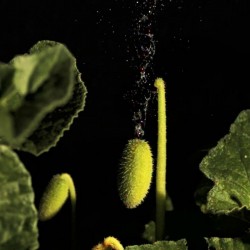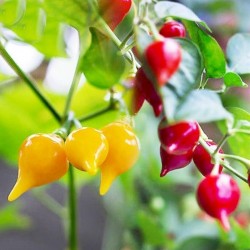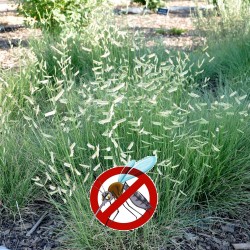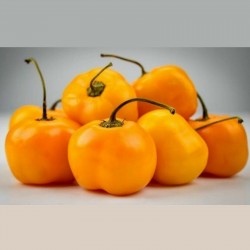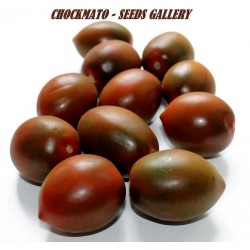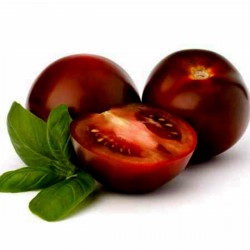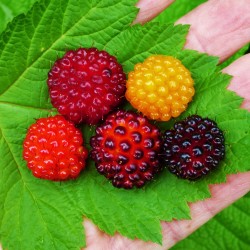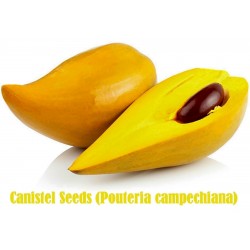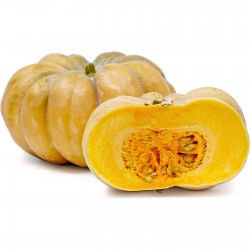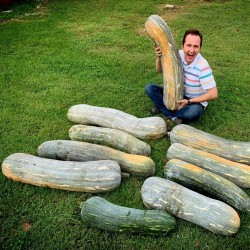.png)
Ποικιλία από την Ελλάδα
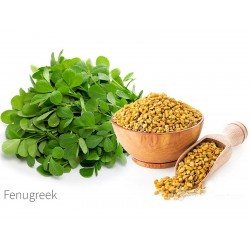
Σπόροι Τριγωνέλλα η...
Τιμή
1,15 €
SKU: VE 64 (2g)
Seeds Gallery Com,
5/
5
<h2><strong>Σπόροι Τριγωνέλλα η Ελληνική (Trigonella foenum-graecum)</strong></h2>
<h2><span style="color: #ff0000;"><strong>Τιμή για το πακέτο των 140 (2 g) σπόροι.</strong></span></h2>
<p>Η Τριγωνέλλα η Ελληνική (Trigonella foenum-graecum) ή άλλως Τριγωνίσκος η Τήλις, χόρτος των Ελλήνων, τριγωνίσκος, Ελληνικός σανός, μοσχοσίταρο, τηντιλίδα, τηντιλίνα, τήλι, γραικόχορτο, ελληνικό τριφύλλι, νυχάκι, στροφίλι, χέλμπα ή τσιμένι[2] (αγγλ. fenugreek), είναι ένα ετήσιο φυτό της οικογένειας των Χεδρωπών ή Φαβίδων (Fabaceae), με φύλλα που αποτελούνται από τρία μικρά αντωοειδή προς επιμήκη φυλλάδια. Καλλιεργείται σε ολόκληρο τον κόσμο ως μια ημίξηρη καλλιέργεια και οι σπόροι του είναι ένα κοινό συστατικό στα φαγητά από την Ινδική υποήπειρο.</p>
<p> </p>
<p>Η τριγωνέλλα (fenugreek) είναι ένα βότανο με πολλές ευεργετικές ιδιότητες για την υγεία σύμφωνα με πολυάριθμες μελέτες. Η επιστημονική του ονομασία της τριγωνέλλας είναι Trigonella foenum-graecum L. (Τριγωνέλλα η ελληνική χλόη - γραικόχορτος) ή κοινά: Τήλι, μοσχοσίταρο, τσιμένι και τηπιλίνα και ανήκει στην οικογένεια των ψυχανθών (Papilionaceae).</p>
<p>Η τριγωνέλλα είναι μονοετές φυτό μέχρι 50 εκατοστά ύψος, γενικά γυμνό, με δυνατή μυρωδιά. Τα στελέχη είναι στρογγυλεμένα, συνήθως είναι όρθια συχνά όμως και λυγισμένα, διακλαδίζονται πολύ σπάνια. Τα φύλλα είναι έμμισχα με 3 οβάλ ή λογχοειδή φυλλάρια. Τα άνθη είναι απλά ή σε ζεύγη στις μασχάλες των φύλλων, η στεφάνη είναι κιτρινόλευκη. Οι καρποί έχουν μέχρι και 10 εκατοστά μήκος, είναι καμπυλωμένοι και έχουν πολύ μακριά και ραμφοειδή κορυφή, περιέχουν 4-20 σπόρους.</p>
<p> </p>
<p>Το φυτό βρίσκεται σε άγρια κατάσταση στην περιοχή της Μεσογείου. Καλλιεργείται κυρίως στην βόρεια Αφρική και Ινδία από σπόρους σε σειρές που απέχουν 20 εκατοστά. Είναι αυτοφυές φυτό της Ελλάδας, βρίσκεται στην Κρήτη, Κεφαλληνία, Μεσσηνία, Βόρεια Ελλάδα και τα νησιά του Ιονίου. Οι καρποί συλλέγονται όταν ωριμάσουν και χωρίζονται οι σπόροι. Η τριγωνέλλα ήταν γνωστή από την αρχαιότητα, την οποία ο Ιπποκράτης είχε σε μεγάλη υπόληψη και μάλιστα τη χρησιμοποιούσε σαν μαλακτικό, αντισηπτικό και το αφέψημα του φυτού το έδινε κατά των ασθενειών της μήτρας.</p>
<p> </p>
<p><strong>Τριγωνέλλα συστατικά</strong></p>
<p>Περιέχει γλίσχρασμα, αρωματικά στοιχεία, άφθονες οργανικές ενώσεις σιδήρου και φωσφόρου. Οι διατροφικές ουσίες που περιλαμβάνονται στους σπόρους της τριγωνέλλας είναι αμινοξέα, ασβέστιο, απαραίτητα λιπαρά οξέα, φολικό οξύ, σίδηρος, μαγνήσιο, μαγγάνιο, φώσφορος, κάλιο, σελήνιο, ψευδάργυρος, βιταμίνη Β1, βιταμίνη Β2, βιταμίνη Β3 και βιταμίνη C.</p>
<p> </p>
<p><strong>Χρησιμοποιούμενα μέρη</strong></p>
<p>Οι ξεραμένοι σπόροι, σκόνη και τα βλαστάρια (φύτρα). Τα φύλλα που συλλέγονται κατά τη βλαστική περίοδο και μπορούν να χρησιμοποιηθούν φρέσκα ή αποξηραμένα.</p>
<p> </p>
<p><strong>Τριγωνέλλα χρήση</strong></p>
<p>Εξωτερικά, χρησιμοποιείται σαν ζεστή κομπρέσα για αποστήματα, σπυριά (βράζετε με νερό σαν χυλός), με τον ίδιο τρόπο που χρησιμοποιείται το λινάρι.</p>
<p>Εσωτερικά χρησιμοποιείται σαν διεγερτικό (τονωτικό) (ένα κουταλάκι σκόνη των σπόρων σε λίγη μαρμελάδα, 3 φορές την ημέρα). Χρησιμοποιείται πολύ στην κτηνιατρική σαν τονωτική σκόνη και για να παχαίνουν οι αγελάδες.</p>
<p>Η τριγωνέλλα σε σπόρους μπορεί να χρησιμοποιηθεί στο μαγείρεμα. Μπορείτε να μειώσετε την πικρή της γεύση καβουρδίζοντας ελαφρώς το σπόρο τριγωνέλλας πριν από τη χρήση.</p>
<p>Η σκόνη τριγωνέλλας χρησιμοποιείται κυρίως σε μείγματα μπαχαρικών (π.χ. συστατικό στο κάρυ), στο σιρόπι σφενδάμου και σε τουρσιά. Επίσης μπορεί να χρησιμοποιηθεί σε μικρές ποσότητες ως μπαχαρικό στις σαλάτες και στην παρασκευή ψωμιού.</p>
<p>Τα βλαστάρια - φύτρα τριγωνέλλας μπορούν να παρασκευαστούν διαποτίζοντας το σπόρο για 12 ώρες σε ζεστό νερό και στη συνέχεια θα βλαστήσουν σε 3-5 ημέρες.</p>
<p>Στον τομέα της μεταποίησης, το εκχύλισμα τριγωνέλλας χρησιμοποιείται σε σαπούνια και σε καλλυντικά.</p>
<p> </p>
<p><strong>Τριγωνέλλα ιδιότητες - δράση</strong></p>
<p>Σύμφωνα με μελέτες η συμπληρωματική χρήση των σπόρων τριγωνέλλας βελτιώνει τον γλυκαιμικό έλεγχο και μειώνει την αντίσταση στην ινσουλίνη σε ασθενείς με ήπιο διαβήτη τύπου 2. Υπάρχει επίσης μια ευνοϊκή επίδραση στην υπερτριγλυκεριδαιμία.</p>
<p>Επίσης έχει αποδειχτεί ότι αυξάνει τα επίπεδα και τη δράση των οιστρογόνων (π.χ. ενισχυμένο μέγεθος του στήθους). Μελλοντικά θα διεξαχθούν επιπλέον μελέτες για να αξιολογηθεί η ιδιότητα της τριγωνέλλας ως εναλλακτική λύση για τη θεραπεία ορμονικής υποκατάστασης (HRT).</p>
<p>Βοηθάει στην αύξηση του σωματικού βάρους και φαίνεται να είναι ευεργετικό ιδιαίτερα σε άτομα με νευρική ανορεξία.</p>
<p>Κάποιες μελέτες έχουν δείξει ότι οι σπόροι τριγωνέλλας μπορούν να αναστείλουν τον καρκίνο του ήπατος και να μειώσουν τα επίπεδα χοληστερόλης στο αίμα.</p>
<p>Ο σπόρος τριγωνέλλας φαίνεται χρήσιμος στη θεραπεία της φλεγμονής και έλκους του στομάχου. Επίσης διεγείρει την γαστρική έκκριση και βοηθά την πέψη. Η δράση του σαν αποχρεμπτικό δεν έχει επιβεβαιωθεί.</p>
<p>Η τριγωνέλλα περιέχει ένα αλκαλοειδές συστατικό την τριγωλλίνη η οποία έχει αποδειχθεί σημαντική στη θεραπεία του καρκίνου. </p>
<p>Γενικότερα οι πρόσφατες έρευνες έχουν εντοπίσει η τριγωνέλλα δρα ως υποχοληστερολαιμικό, αντιλιπιδαιμικό, αντιοξειδωτικό, ηπατοπροστατευτικό, αντιφλεγμονώδες, αντιβακτηριακό, αντιμυκητιακό, αντιπυρετικό, κατά του έλκους, αντικαρκινικό και στην αντιμετώπιση διάφορων άλλων προβλημάτων υγείας.</p>
<p>Εξωτερικά οι σπόροι είναι μαλακτικοί και επιταχύνουν την θεραπεία της διαπύησης και των μολύνσεων. Επίσης, μπορούν χρησιμοποιηθούν ως κατάπλασμα (τυλιγμένο σε ύφασμα) για αποστήματα ή σπυριά, εγκαύματα, θεραπεία τοπικού πόνου και οιδήματος (φλεγμονή), μυϊκό πόνο, πόνο και διόγκωση των λεμφαδένων (λεμφαδενίτιδα), πόνος στα δάκτυλα (ποδάγρα), πληγές, έλκη ποδιών, έκζεμα κλπ, ή για πλύσεις σε περιπτώσεις υπερβολικών κολπικών εκκρίσεων. Τέλος, χρησιμοποιείται για τη θεραπεία της κυτταρίτιδας.</p>
<p> </p>
<p><strong>Τριγωνέλλα θηλασμός </strong></p>
<p>Υπάρχουν αρκετές αναφορές ότι η κατανάλωση σκόνης από σπόρους τριγωνέλλας αυξάνει την ημερήσια παραγωγή γάλακτος στις θηλάζουσες γυναίκες, αλλά τα στοιχεία το που επιβεβαιώνουν είναι περιορισμένα. Σε μια πρώιμη μελέτη, θηλάζουσες μητέρες που έπιναν ένα συγκεκριμένο τσάι που περιείχε τριγωνέλλα, αύξησαν την παραγωγή γάλακτος.</p>
<p> </p>
<p><strong>Τριγωνέλλα δοσολογία</strong></p>
<p>Η κατάλληλη δοσολογία τριγωνέλλας εξαρτάται από διάφορους παράγοντες όπως η ηλικία του χρήστη, η υγεία και διάφορες άλλες συνθήκες. Μελέτες που διερευνούν τη χρήση της τριγωνέλλας στο διαβήτη και τη μείωση της χοληστερόλης έχουν χρησιμοποιήσουν 5 γραμμάρια σπόρους τριγωνέλλας ή 1 γραμμαρίου εκχυλίσματος τριγωνέλλας ανά ημέρα αντίστοιχα. Να θυμάστε ότι τα φυσικά προϊόντα δεν είναι απαραίτητα πάντα ασφαλή και οι συνιστώμενες δόσεις είναι σημαντικές. Να ακολουθείτε πάντα τις σχετικές οδηγίες στις ετικέτες των προϊόντων και συμβουλεύεστε το φαρμακοποιό, το διαιτολόγο ή το γιατρό σας πριν από τη χρήση.</p>
<p>Οι δόσεις τριγωνέλλας που συχνά προτείνονται:</p>
<p>Τριγωνέλλα σε κάψουλες (580 - 610 mg): 2-4 κάψουλες, 3 φορές την ημέρα ή 6-12 κάψουλες (σύνολο) ανά ημέρα ή 1200-2400 mg, 3 φορές την ημέρα (3,5 έως 7,3 γρ./ημέρα).</p>
<p>Τριγωνέλλα σε κάψουλες (500 mg): 7-14 κάψουλες (σύνολο) ανά ημέρα.</p>
<p>Τριγωνέλλα σε σκόνη ή σε σπόρους: ½ - 1 κουταλάκι του γλυκού, τρεις φορές την ημέρα ή 1 κάψουλα = ¼ κουταλάκι του γλυκού, μπορεί να αναμιχθεί με λίγο νερό ή χυμό.</p>
<p>Τριγωνέλλα βάμμα: 1-2 ml, 3 φορές την ημέρα (βλέπετε τις οδηγίες της συσκευασίας)</p>
<p>Τριγωνέλλα τσάι: ένα φλιτζάνι του τσαγιού, 2-3 φορές την ημέρα.</p>
<p> </p>
<p><strong>Τριγωνέλλα παρενέργειες</strong></p>
<p>Σύμφωνα με μελέτες η τριγωνέλλα δεν παρουσιάζει ιδιαίτερες παρενέργειες και θεωρείται ασφαλής όταν λαμβάνεται από το στόμα, σε ποσότητες που βρίσκονται στα τρόφιμα. Ακόμα, θεωρείται ασφαλής σε ποσότητες που λαμβάνεται για φαρμακευτικούς σκοπούς (ποσότητες μεγαλύτερες από ότι στα τρόφιμα) για έως και 6 μήνες.</p>
<p>Οι παρενέργειες από τη λήψη τριγωνέλλας μπορούν να είναι διάρροια, στομαχικές διαταραχές, φούσκωμα, αέρια και οσμή σφενδάμου στα ούρα. Η τριγωνέλλα μπορεί επιπλέον να προκαλέσει ρινική συμφόρηση, βήχα, συριγμό, οίδημα στο πρόσωπο και αλλεργικές αντιδράσεις σε άτομα με υπερευαισθησία (π.χ. άτομα με αλλεργία στα φιστίκια και στα ρεβίθια).</p>
<p>Η τριγωνέλλα μπορεί να επηρεάσει τα επίπεδα σακχάρου στο αίμα σε άτομα με διαβήτη και να προκαλέσει και υπογλυκαιμία. Έτσι, θα πρέπει πάντα να παρακολουθούν το σάκχαρό τους όταν χρησιμοποιών τριγωνέλλα.</p>
<p>Η τριγωνέλλα είναι δεν είναι ασφαλής στην εγκυμοσύνη, όταν λαμβάνεται σε μεγαλύτερες ποσότητες από εκείνες που περιέχονται στα τρόφιμα, διότι μπορεί να προκαλέσει πρόωρες συστολές της μήτρας. </p>
<p>Τριγωνέλλα ίσως δεν είναι ασφαλής για τα παιδιά. Ορισμένες μελέτες έχουν συνδέσει το τσάι που περιέχει τριγωνέλλα με απώλεια συνείδησης στα παιδιά.</p>
<p>Προσοχή σε άτομα που λαμβάνουν αντιπηκτικά φάρμακα όπως η βαρφαρίνη ή ηπαρίνη. Οι ασθενείς που λαμβάνουν αντιπηκτικά θα πρέπει να συμβουλευτούν το γιατρό τους πριν από τη λήψη τριγωνέλλας και έτσι ώστε να γίνει προσαρμογή της δοσολογίας.</p>
<p> </p><script src="//cdn.public.n1ed.com/G3OMDFLT/widgets.js"></script>
VE 64 (2g)








